Family : Carangidae

Text © Giuseppe Mazza

English translation by Mario Beltramini
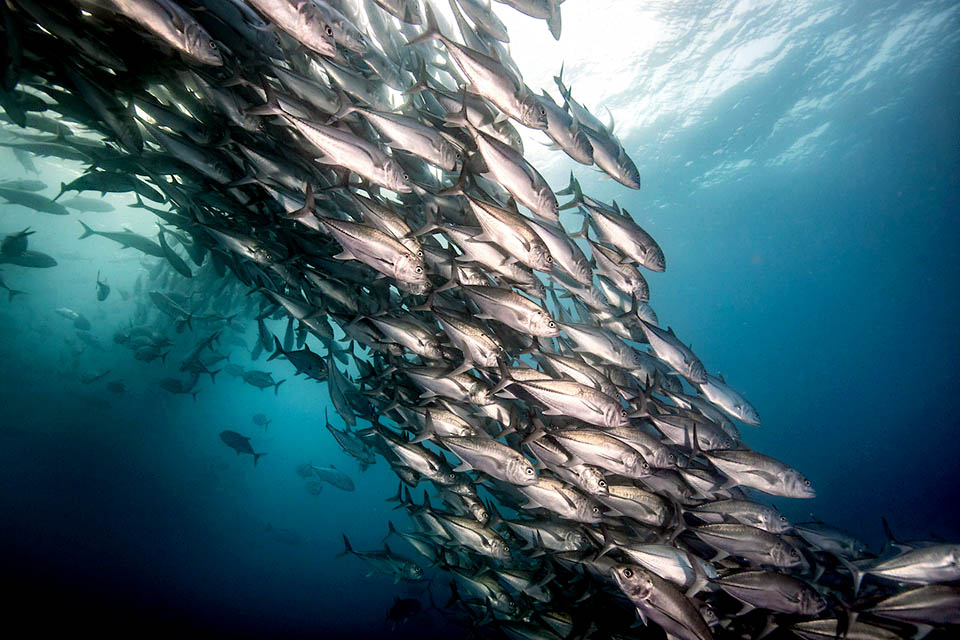
Caranx sexfasciatus s frequent in the tropical waters of Indian and Pacific oceans, but is totally absent in the Atlantic © www.carlosestape.photoshelter
With about 30 genera and 150 species, the Carangidae are a family of fish important for human nutrition, even if are not missing unusual and attractive species in plain sight in the large public aquaria, such as Alectis indica or Gnathanodon speciosus.
They are fish with the body usually compressed on the sides, fast-swimming predators, common in the tropical waters but present also in the Mediterranean with modest-sized species like Trachurus trachurus or the Greater amberjack (Seriola dumerili), appreciated by the gourmets, that reaches the length of 2 m and more than 50 kg of weight.
Even if it has some connoisseurs, Caranx sexfasciatus Quoy & Gaimard 1825, is not a very valuable fish, but surely precious for the subsistence fishing of many local populations.
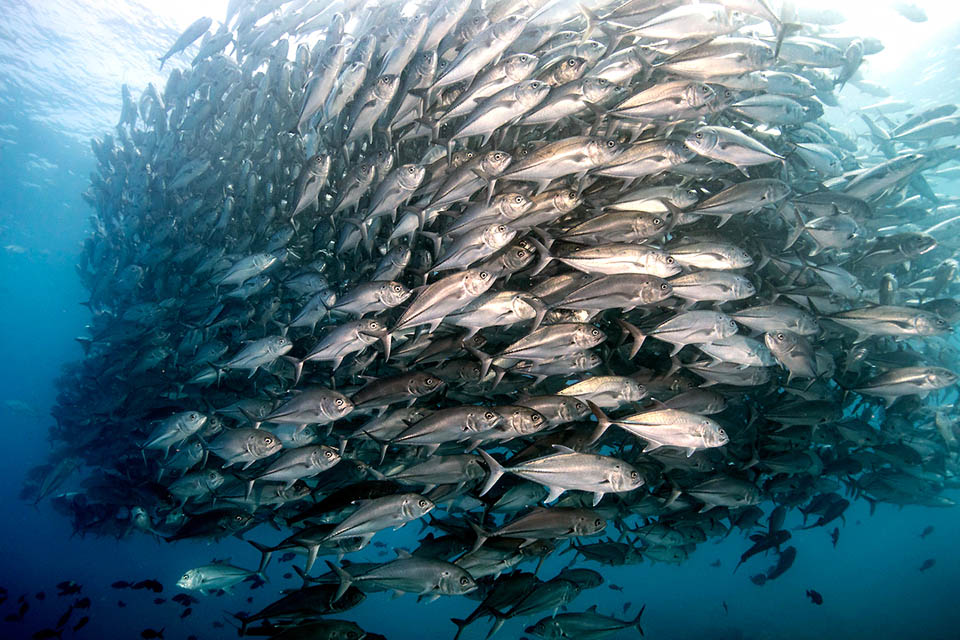
It forms impressive schools, with even 1500 individuals, moving lazily the day and disperse at dusk to hunt alone or in small groups during the night © www.carlosestape.photoshelter
They say that the genus Caranx should derive from “carangue”, the name the Antillean French gave to these fish, even if Lacépèdes who created it in 1801, was referring to the Greek “kara”, head, due to the unusual prominent shape of the head. Conversely, the specific term sexfasciatus refers to the 5-6 dark vertical bands typical of the juveniles.
Zoogeography
Rightly known as Six-banded jack, but also as Bigeye jack, due to the big eye with well developed fatty and wide at the posterior broad eyelid, or Giant Indo-Pacific jack, Caranx sexfasciatus is actually present in the Indian Ocean and in the Pacific whilst is totally absent in the Atlantic. It reaches north of Australia, the southern part of Japan and, southwards, New Caledonia.
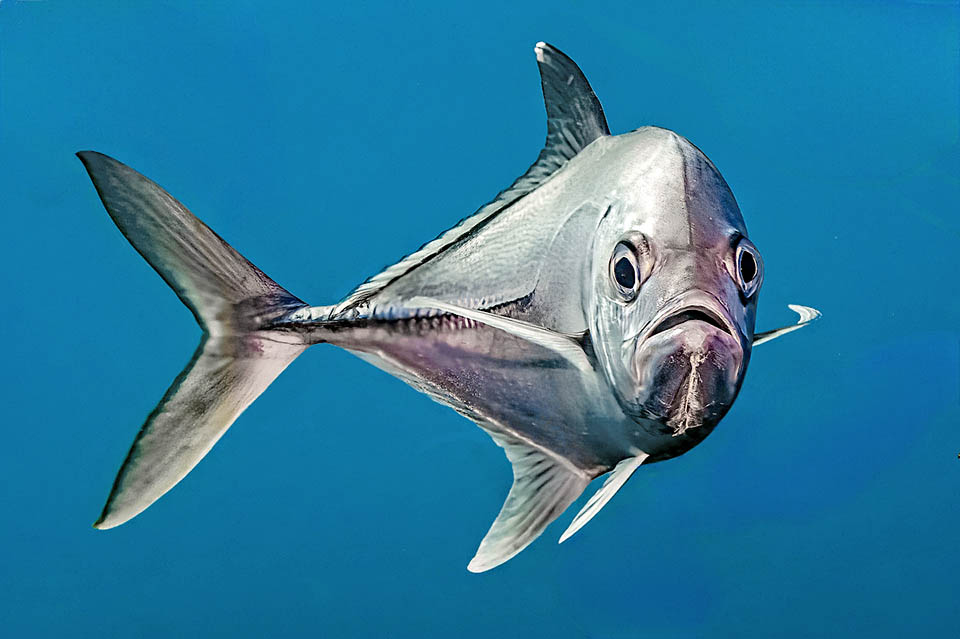
In adults are characteristic the big eyes with fatty eyelids and the tiny white dot at the top of the dorsal fin © www.carlosestape.photoshelter
Ecology-Habitat
It is a species associated with the reefs, loving temperatures between 26 and 29 °C and usually not descending over the depth of 100 m. It lives along the coasts, also in those of islands lost in the ocean, and especially when young can be met at the mouth of the rivers in brackish waters where, at times, goes up the first stretch of the river.
It swims, slow and lazy, during the day in dense schools that may consist of 1500 individuals. Towards evening they separate for hunting alone or in small groups during the night, unlike most of Carangidae who, conversely, feed during the day.
Morphophysiology
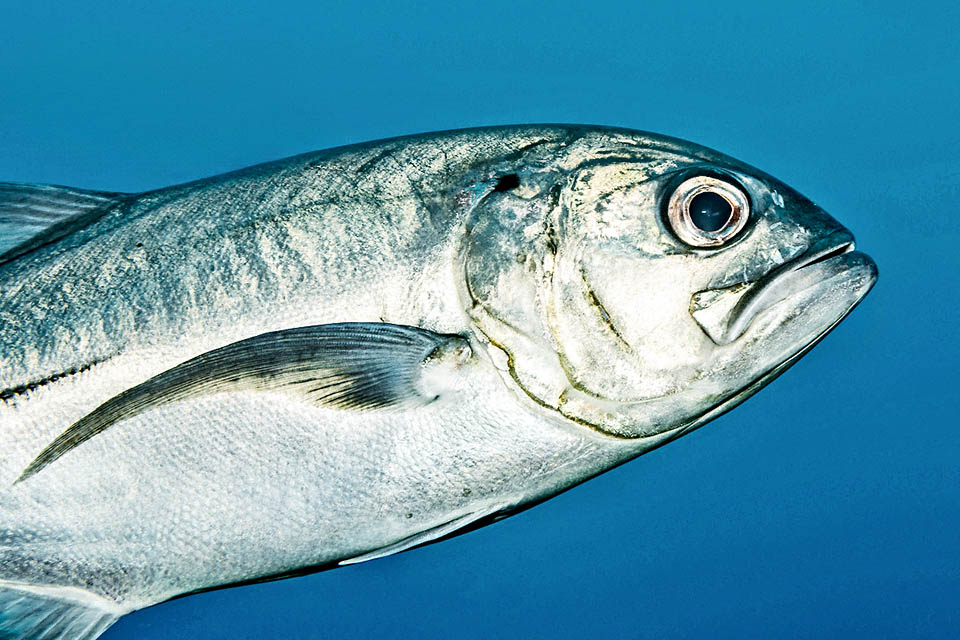
To note also the typical black tiny dot on top of the operculum and the long falcate pectorals ensuring with the very forked caudal a fast swimming © www.carlosestape.photoshelter
Caranx sexfasciatus may reach the length of 120 cm and 18 kg of weight, but the current size is about half.
The body, moderately compressed, has the profile of the head rigid with the maxillary joint aligned under the eye.
In the adults the upper jaw has an outer row of solid canines well spaced and an inner one of small villiform teeth, whilst below there is only one row of spaced conical teeth.
The lateral line, important for the fish moving in school, hase in the anterior part, with the typical arched shape of the Carangidae, 49-50 scales, and in the straight side towards the tail, 27-36 bony shields that can be noticed at first sight because stand out almost black on the light body.
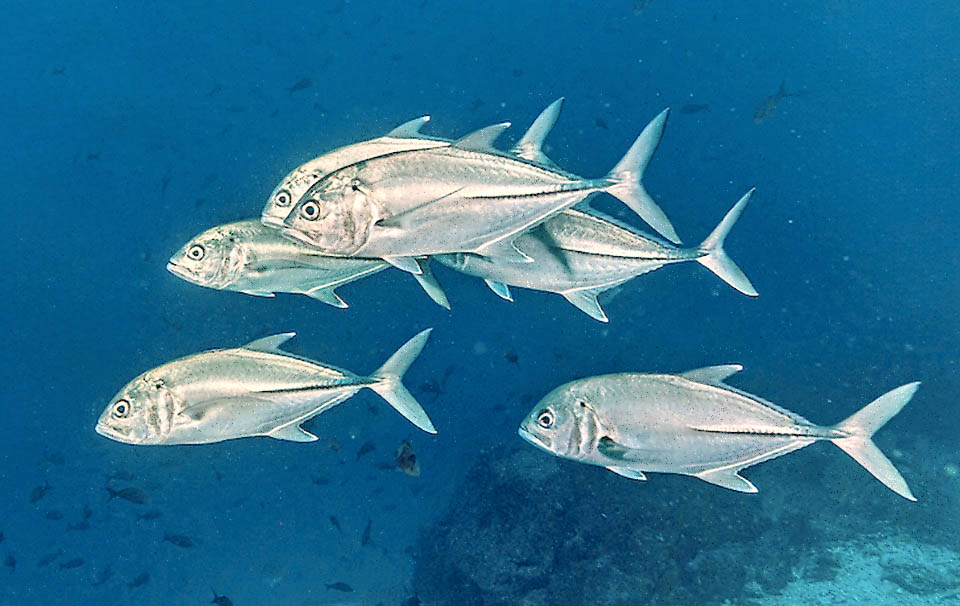
Even though the current size is about half, Caranx sewfasciatus can reach the length of 120 cm and 18 kg of weight © www.carlosestape.photoshelter
There are two dorsal fins: the first, folded while swimming, with 8 spiny rays and the second with one spine followed by 15-17 unarmed rays; the anal, with great anterior lobes is formed by 2 parts having totally 3 spines and 14 to 17 soft rays; the pelvic ones have one spine and 17-18 unarmed rays. The caudal is strongly forked and the falcate pectoral fins, longer than the head, are those typical to a fast swimming fish.
The scales, tiny and cycloid, are present also on the chest and the livery changes with age. In adults the upper part of the body is olive grey with sparkling reflections, whilst the lower tends to silver white. We note a characteristic small black dot in the upper corner of the operculum and the apex of the dorsal fin is white. The juveniles display yellow shades on the lower part of the body and the fins, but are recognized above all by the 5-6 dark vertical bands that have given the name to the species.
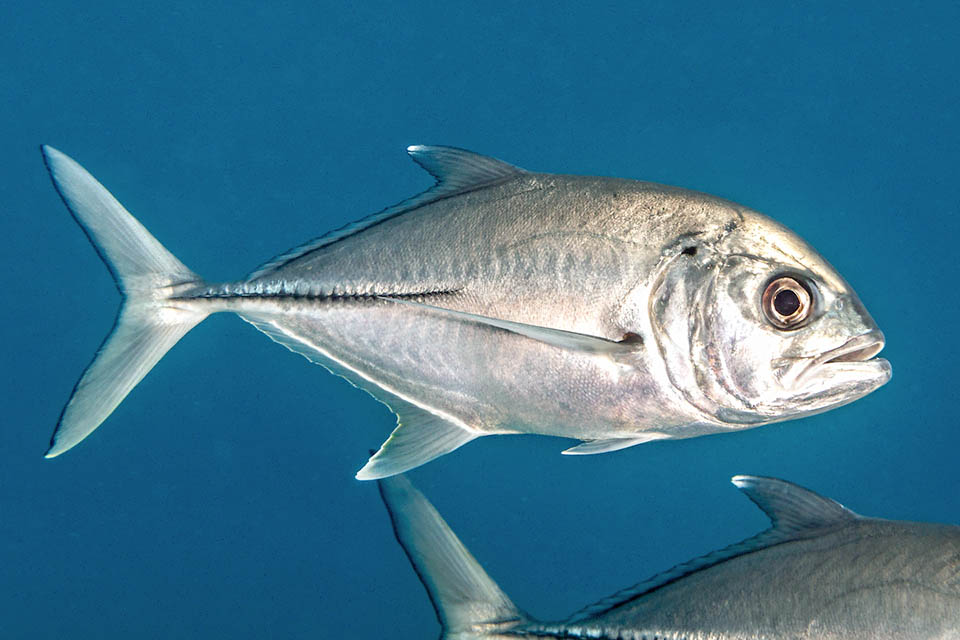
Adults feed mainly on fish and squids, but also on gastropods, ascidians, jellyfish, crustaceans and marine insects © www.carlosestape.photoshelter
Ethology-Reproductive Biology
When young Caranx sexfasciatus feeds almost exclusively on crustaceans and fish eggs, whilst the adults, without forgetting the delicious eggs, base their diet on fish and squids, enriching it with gastropods, ascidians, jellyfish, crustaceans, especially shrimps, and even insects.
As incredible as it may seem, even in the middle of the oceans, in fact, we find some Heteropterans, the
Halobates, sea skaters belonging to the family of the Gerridae living, like those present on the puddles of the mainland, moving jerkily on the surface of the water.
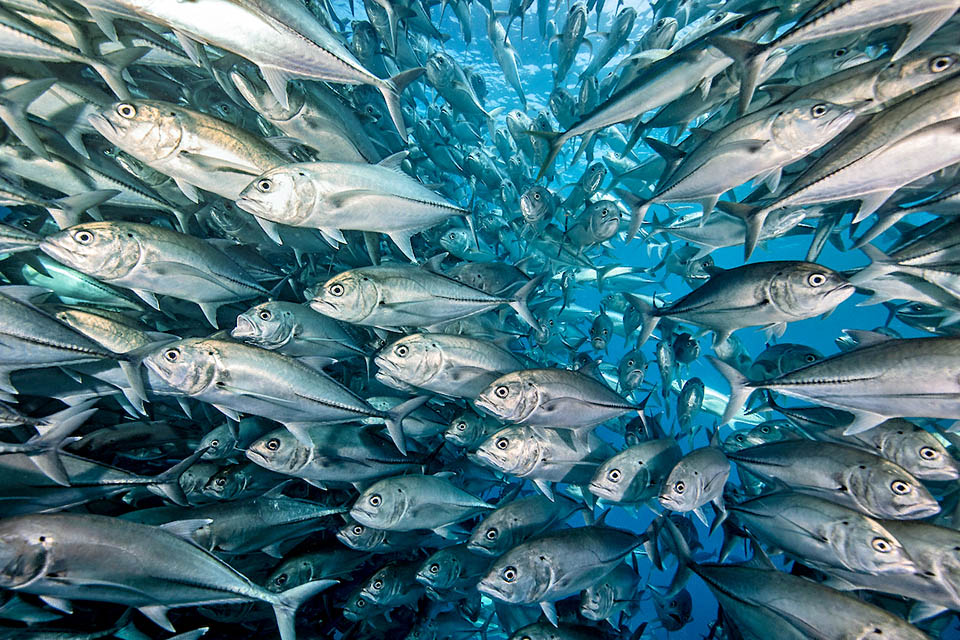
Huge aggregations form for reproduction and as occurs with some groupers for the occasion the males change colour © www.carlosestape.photoshelter
Caranx sexfasciatus reaches sexual maturity when about 40 cm and reproductive aggregations take form between July and September in the Eastern Pacific and in South Africa from November to March.
For the occasion, a bit as it happens for Kyphosus sectatrix and some groupers like Epinephelus striatus or Plectropomus laevis, the male of a couple gets away from the school with its female and rises with this on the water column over the school turning black.
This is the signal that precedes mating. The males who are below, perhaps for an instinctive reaction of jealousy, also instantly colour themselves and all couples go up to entrust the gametes to the currents. When they get down, the colour then immediately becomes normal.
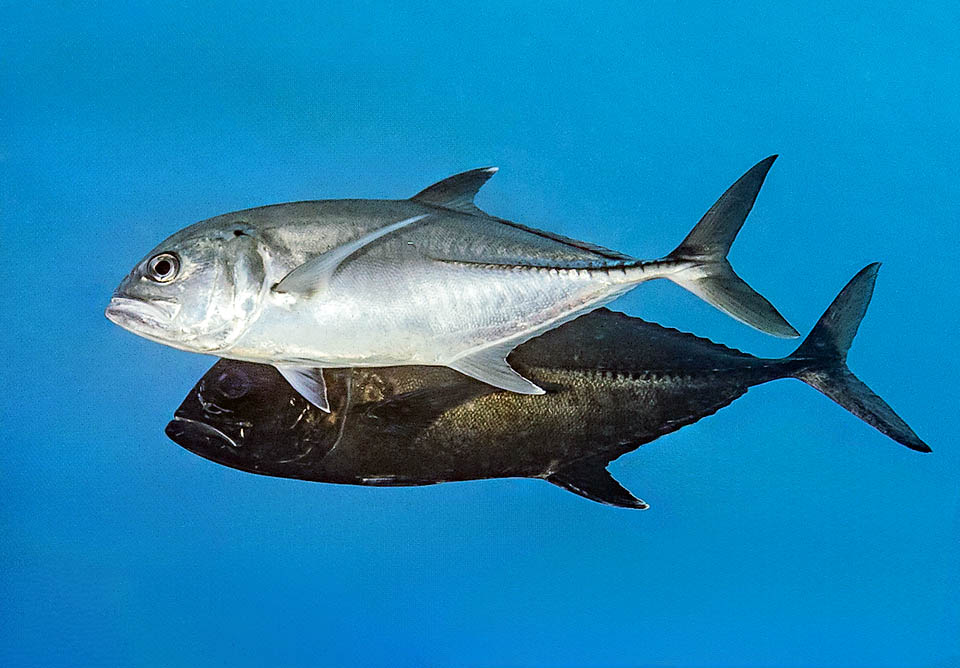
They become black while going up with the partner to lay in the water column over the school and this leads the others to do the same © www.carlosestape.photoshelter
The resilience of the species is mediocre with a possible doubling of the populations in 1,4-4,4 years and the fishing vulnerability, moderately high, marks 45 on a scale of 100.
Rather than being a victim of the sport fishermen, it’s a victim of subsistence fishing and Caranx sexfasciatus appears regularly fresh, dried or salted, on the local markets. It is easily attracted by light during the night and the remarkable dimensions of the schools allow for large catches.
To give an idea, in Saudi Arabia they are talking of about 600 tons per year and in Mexico of 900, although in some locations they report cases of ciguatera poisonings when the Giant Indo-Pacific jack has preyed on fish that accumulate in their diet the toxin produced by the dinoflagellate Gambierdiscus toxicus.
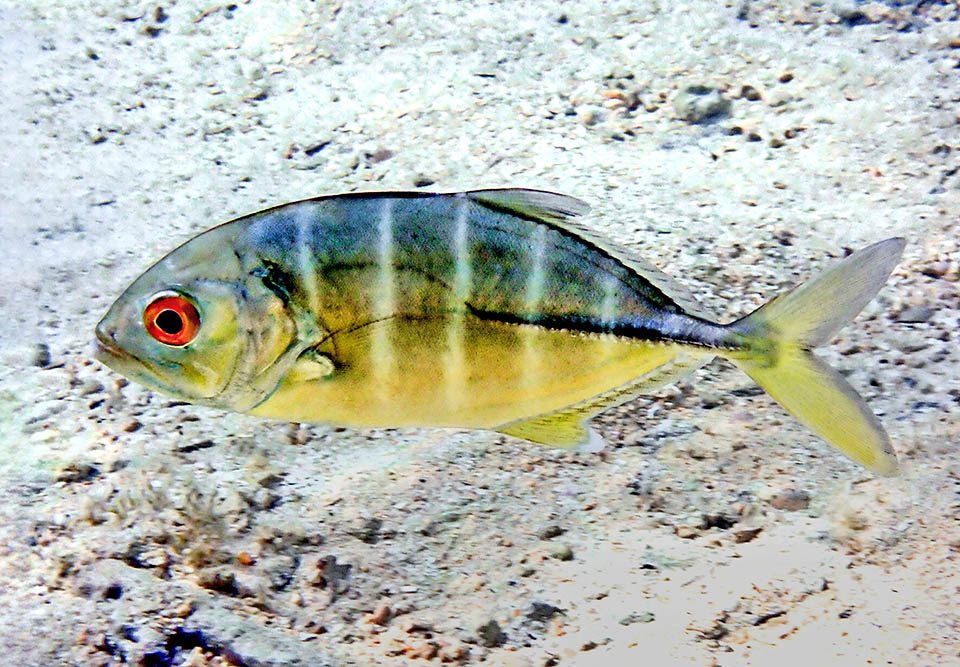
Juveniles show yellow shades, but especially are recognized for the 5-6 vertical dark bands that gave the name to the species © Susan Prior
Due to the vast diffusion, Caranx sexfasciatus is not in any case an endangered species and since 2018 appears as “LC Least Concern” in the IUCN Red List.
Synonyms
Caranx belengerii Cuvier, 1833; Caranx peronii Cuvier, 1833; Caranx xanthopygus Cuvier, 1833; Caranx flavocoeruleus Temminck & Schlegel, 1844; Caranx paraspistes Richardson, 1848; Caranx tapeinosoma Bleeker, 1856; Carangus marginatus Gill, 1863; Caranx marginatus (Gill, 1863); Caranx sexfaciatus marginatus (Gill, 1863); Carangus rhabdotus Jenkins, 1903; Carangus elacate Jordan & Evermann, 1903; Caranx elacate (Jordan & Evermann, 1903); Caranx sexfaciatus elacate (Jordan & Evermann, 1903); Caranx thompsoni Seale, 1905; Caranx butuanensis Seale, 1910; Caranx oshimai Wakiya, 1924.
→ For general information about FISH please click here.
→ For general information about BONY FISH please click here
→ For general information about CARTILAGINOUS FISH please click here.
→ To appreciate the BIODIVERSITY of BONY FISH please click here.
→ To appreciate the BIODIVERSITY of CARTILAGINOUS FISH please click here.
